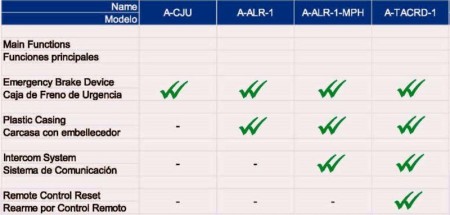Pneumatic Suspension Control System
Ametsis elements for control of pneumatic suspension can adapt to the particular characteristics of each vehicle.
Its design and construction, in addition to make them safe and reliable, ensures a minimum consumption of air, without affecting the stability and comfort of vehicles.
- Levelling Valves
- Mean pressure valves
- Overflow valves
Pneumatic Suspension Control.pdf
Documento Adobe Acrobat [2.7 MB]
Sanding Control System
The sandbox type A allows, through an electronic system of control, to regulate the flow of sand depending on the speed of the vehicle.
The sandbox has two pneumatic connections, one for the feeding of sand through the ejector and another for splashing sand, to prevent compression of sand inside the drawer.
There is also the possibility to install a heater that will allow the sand drying.
Emergency Brake Devices for Passengers
The Wireless Reset Alarm Device for Passengers (SIRPAD) allows the safe remote resetting of the passenger alarm device without the driver leaving his cabin. The developed system consists on a network of coordinators with Mesh topology that ensures the propagation of the reset signal between the alarm devices throughout the train. Being a wireless system, its implementation is easier and cheaper in both new vehicles and those already in service.
Ametsis also has available devices of passenger alarm, type A-ALR-2-MPH and TACRD-1 for rearmament by remote control. Both teams have passenger-driver intercoms.
The A-ALR-2-MPH devices must necessarily be upgraded once it has been actuated by the passenger, using the chief of the train key, thus forcing his presence to rearm the shooter.
The TACRC-1 devices allow using a wiring circuit between the desk and shooters; rearm them without the need of the presence of the chief of the train on the shooter to rearm it, keeping, however, also the possibility of rearmament with the chief of the train key.
This type of handles facilitate the operation of the trains with automatic driving and decrease delays in the movement, because it is not necessary that trains with only one agent leave the cabin to intervene personally on the handles.
Emergency Brake Handle.pdf
Documento Adobe Acrobat [2.6 MB]
Pantograph Lift Control System
Any vehicle either a subway, either a suburban train or a locomotive with its composition must at all times be available to put it into service.
During the time that units are parked, especially for long periods of time of time (at night, Valley hours, etc.), the pantograph is, in most cases, disconnected from the catenary just in case something happens when the vehicle must be put into service, there would not be enough air in the installation to lift the pantograph and activate all services.
This is why the rail vehicle mounts an auxiliary compressor group to the pantograph-lift up along with other additional pneumatic components for their command and control. This group auxiliary pantograph- lift up is formed by a single-cylinder compressor powered by a DC motor that allows an alternative or continuous operation depending on the engine that is used.
This equipment can be used for auxiliary services and according to the specific needs of each application, as it could be the loosening of the parking brake.
Acustic Signals System - UIC Hi/Low Frecuency Horns - Whistles - Control
Easy but important equipment with a view to the safety of the train is acoustic warning system.
Ametsis has two types of specialized horns by UIC (Union Internationale des Chemins de fer): One of low tone and another of high tone according to the UIC644, for use in any rail vehicle.
















